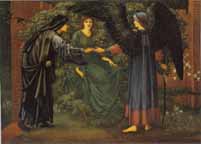 The Heart of the Rose, which Sir Edward Burne-Jones began in 1889, was part of a trilogy that included The Pilgrim at the Gate of Idleness and Love Leading the Pilgrim. Burne-Jones, who was quite taken by Chaucer's Romaunt of the Rose, upon which he based these paintings, spent nearly 20 years with the idea of creating artwork on this poem's theme. Burne-Jones conceived the three paintings sequentially, the first of which was The Pilgrim at the Gate of Idleness, in which the Pilgrim meets Idleness, personified as a maid. The second segment consists of the Pilgrim being led through a briar thicket after escaping temptation. Finally, The Heart of the Rose, depicts love, in the form of a winged creature, who leads the Pilgrim to the Rose, a beautiful woman, dressed in green, who is resting within a rose bush. The clothing of Love and the Pilgrim have a similar color. The Pilgrim wears a black cloak and a blue robe underneath — Love has black wings and a blue robe. Burne-Jones pays careful attention to stylistic devices in The Heart of the Rose — the elusive woman almost blends in with the bush within which she is sitting, adding to her mysterious nature. Her apprehensive countenance appears is a stark comparison to the fully extended wings of Love. The Pilgrim looks haggard as he has made a long journey to come to this point — to his true love.
The Heart of the Rose, which Sir Edward Burne-Jones began in 1889, was part of a trilogy that included The Pilgrim at the Gate of Idleness and Love Leading the Pilgrim. Burne-Jones, who was quite taken by Chaucer's Romaunt of the Rose, upon which he based these paintings, spent nearly 20 years with the idea of creating artwork on this poem's theme. Burne-Jones conceived the three paintings sequentially, the first of which was The Pilgrim at the Gate of Idleness, in which the Pilgrim meets Idleness, personified as a maid. The second segment consists of the Pilgrim being led through a briar thicket after escaping temptation. Finally, The Heart of the Rose, depicts love, in the form of a winged creature, who leads the Pilgrim to the Rose, a beautiful woman, dressed in green, who is resting within a rose bush. The clothing of Love and the Pilgrim have a similar color. The Pilgrim wears a black cloak and a blue robe underneath — Love has black wings and a blue robe. Burne-Jones pays careful attention to stylistic devices in The Heart of the Rose — the elusive woman almost blends in with the bush within which she is sitting, adding to her mysterious nature. Her apprehensive countenance appears is a stark comparison to the fully extended wings of Love. The Pilgrim looks haggard as he has made a long journey to come to this point — to his true love.
Discussion Questions
Why did Burne-Jones choose the color scheme he did in The Heart of the Rose? In particular, why did he make the wings of Love black, a color normally not associated with purity and romance?
How does Burne-Jones' work, Pygmalion compare to the abovementioned trilogy? The conclusion of Pygmalion is considerably different from that of The Heart of the Rose, in which much is left to be inferred, why did Burne-Jones choose such an ambiguous ending when his other paintings such as Pygmalion had a very clear ending?
There are certain details that add to the overall effect of the painting. Explain the significance of the white flowers that are growing in front of the red brick wall and the birds flying into the scene from the left.
The scene appears to be occurring in a very small and humble area of land, why do you suppose Burne-Jones chose not to create an effect of grandeur in the ending of his trilogy?
Victorian
Web
Artists
E. Burne
Jones
Paintings
Leading
Questions
Last modified 25 October 2006
